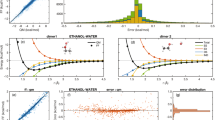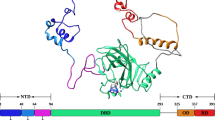Abstract
Oncogenic p21 protein, encoded by theras-oncogene, that causes malignant transformation of normal cells and many human tumors, is almost identical in sequence to its normal protooncogene-encoded counterpart protein, except for the substitution of arbitrary amino acids for the normally occurring amino acids at critical positions such as Gly 12 and Gin 61. Since p21 is normally activated by the binding of GTP in place of GDP, it has been postulated that oncogenic forms must retain bound GTP for prolonged time periods. However, two multiply substituted p21 proteins have been cloned, neither of which binds GDP or GTP. One of these mutant proteins with Val for Gly 10, Arg for Gly 12, and Thr for Ala 59 causes cell transformation, while the other, similar protein with Gly 10, Arg 12, Val for Gly 13 and Thr 59 does not transform cells. To define the critical conformational changes that occur in the p21 protein that cause it to become oncogenic, we have calculated the low energy conformations of the two multiply substituted mutant p21 proteins using a new adaptation of the electrostatically driven Monte Carlo (EDMC) technique, based on the program ECEPP. We have used this method to explore the conformational space available to both proteins and to compute the average structures for both using statistical mechanical averaging. Comparison of the average structures allows us to detect the major differences in conformation between the two proteins. Starting structures for each protein were calculated using the recently deposited x-ray crystal coordinates for the p21 protein, that was energy-refined using ECEPP, and then perturbed using the EDMC method to compute its average structure. The specific amino acid substitutions for both proteins were then generated into the lowest energy structure generated by this procedure, subjected to energy minimization and then to full EDMC perturbations. We find that both mutant proteins exhibit major differences in conformation in specific regions, viz., residues 35–47, 55–78, 81–93, 96–110, 115–126, and 123–134, compared with the EDMC-refined x-ray structure of the wild-type protein. These regions have been found to be the most flexible in the p21 protein bound to GDP from prior molecular dynamics calculations (Dykeset al., 1993). Comparison of the EDMC-average structure of the transforming mutant with that of the nontransforming mutant reveals major structural differences at residues 10–16, 32–40, and 60–68. These structural differences appear to be the ones that are critical in activation of the p21 protein. Analysis of the correlated motions of the different regions of the two mutant proteins reveals that changes in the conformation of regions in the carboxyl half of the protein are caused by changes in conformation around residues 10–16 and are transmitted by means of residues around Gln 61. The latter region therefore constitutes a “molecular switch” unit, in agreement with conclusions from prior work.
Similar content being viewed by others

References
Adari, H., Lowy, D. R., Willumsen, B. F., Der, C. J., and McCormick, F. (1988).Science 240, 518–521.
Almoguerra, C., Shibata, D., Forrester, K., Martin, J., Arnheim, M., and Perucho, M. (1988).Cell 53, 813–815.
Barbacid, M. (1987).Ann. Rev. Biochem. 56, 779–827.
Birchmeier, C., Broek, D., and Wigler, M. (1985).Cell 43, 615–621.
Chardin, P., Camonis, J. H., Gale, N. W., Van Aelst, L., Schlessinger, J., Wigler, M., and Bar-Sagi, D. (1993).Science 260, 1338–1343.
Chen, J. M., Lee, G., Murphy, R. B., Carty, R. P., Brandt-Rauf, P. W., Friedman, E., and Pincus, M. R. (1989).J. Biomol. Struct. Dyn. 6, 859–875.
Chen, J. M., Lee, G., Brandt-Rauf, P. W., Murphy, R. B., Gibson, K. D., Scheraga, H. A., Rackovsky, S., and Pincus, M. R. (1990a).Int. J. Peptide Protein Res. 36, 247–254.
Chen, J. M., Lee, G., Brandt-Rauf, P. W., Murphy, R. B., Rackovsky, S., and Pincus, M. R. (1990b).J. Protein Chem. 9, 543–547.
Chung, D. L., Brandt-Rauf, P. W., Murphy, R. B., Nishimura, S., Yamaizumi, Z. Weinstein, I. B., and Pincus, M. R. (1991).Anticancer Res. 11, 1373–1378.
Clanton, D. J., Lu, Y., Blair, D. G., and Shih, T. Y. (1987).Mol. Cell. Biol. 7, 3092–3097.
Dauber-Osguthorpe, P., Roberts, V. A., Osguthorpe, D. J., Wolff, J., Genest, M., and Hagler, A. T. (1988).Proteins: Structure, Function Genet. 4, 31–47.
Deshpande, A. K., and Kung, H.-F. (1987).Mol. Cell. Biol. 7, 1285–1288.
Dykes, D. C., Friedman, F. K., Luster, S. M., Murphy, R. B.; Brandt-Rauf, P. W., and Pincus, M. R. (1994).J. Biomol. Struct. Dynamics 11, 443–458.
Forester, K., Almoguerra, C., Han, K., Grizzle, W., and Perucho, M. (1987).Nature 327, 298–303.
Franken, S. M., Scheidig, A. J., Krengel, U., Rensland, H., Lautwein, A., Geyer, M., Scheffzek, K., Goody, R. S., Kalbitzer, H. R., Pai, E. F., and Wittinghofer, A. (1993)Biochemistry 32, 8411–8420.
Guerrero, I., Wong, H., Pellicer, A., and Burstein, D. E. (1987).J. Cell Physiol. 129, 71–76.
Hagag, N., Halegoua, S., and Viola, M. (1986).Nature 319, 680–682.
Hancock, J. F., Magee, A. I., Childs, J. E., and Marshall, C. J. (1989).Cell 57, 1167–1177.
Haspel, J., Dykes, D. C., Friedman, F. K., Robinson, R., Chung, D., Ronai, Z., Brandt-Rauf, P. W., Baskin, L., Weinstein, I. B., Nishimura, S., Yamaizumi, Z., Singh, G., Murphy, R. B., and Pincus, M. R. (1992).Med. Sci. Res. 20, 809–811.
Krengel, U., Schlichting, L., Scherer, A., Schumann, R., Frech, M., John, J., Kabsch. W., Pai, E. F., and Wittinghofer, A. (1990).Cell 62, 539–548.
Lee, G., Ronai, Z. A., Pincus, M. R., Murphy, R. B., Delohery, T. M., Nishimura, S., Yamaizumi, Z., Weinstein, I. B., and Brandt-Rauf, P. W. (1990).Med. Sci. Res. 18, 771–772.
Li, Z., and Scheraga, H. A. (1987).Proc. Natl. Acad. Sci. USA 84, 6611–6615.
Liwo, A., Pincus, M., Wawak, R. J., Rackovsky, S., and Scheraga, H. A. (1993).Protein Science 2, 1715–1731.
Longu, P. A., Broido, M. S., Chen, J., and Pincus, M. R. (1988).Biochem. Biophys. Res. Comm. 157, 776–782.
Medema, R. H., Wubbolts, R., and Bos, J. L. (1991).Mol. Cell. Biol. 11, 5963–5967.
Moodie, S. A., Willumsen, B. M., Weber, M. J., and Wolffman, A. (1993).Science 260, 1658–1661.
Nemethy, G., Pottle, M. S., and Scheraga, H. A. (1983).J. Phys. Chem. 87, 1883–1887.
Némethy, G., Gibson, K. D., Palmer, K. A., Yoon, C. N., Paterlini, G., Zagari, A., Rumsey, S., and Scheraga, H. A. (1992).J. Phys. Chem. 96, 6472–6484.
Noguti, T., and Go, N. (1989).Proteins 5, 97–103.
Pai, E. F., Krengel, U., Petsko, G. A., Goody, R. S., Kabsch, W., and Wittinghofer, A. (1990).EMBO J. 9, 2351–2359.
Palmer, K. A., and Scheraga, H. A. (1991).J. Comput. Chem. 12, 505–526.
Piela, L., and Scheraga, H. A. (1987).Biopolymers 26, S33-S58.
Pincus, M. R., van Renswoude, J., Harford, J. B., Chang, E. H., Carty, R. P., and Klausner, R. D. (1983).Proc. Natl. Acad. Sci. USA 80, 5253–5257.
Pincus, M. R., Brandt-Rauf, P. W., Gibson, K., Carty, R. P., Lubowsky, J., Avitable, M., and Scheraga, H. A. (1987).Proc. Natl. Acad. Sci. USA 89, 8375–8379.
Ripoll, D., and Scheraga, H. A. (1988).Biopolymers 27, 1283–1303.
Scheraga, H. A. (1988).Chemica Scripta 29A, 3–13.
Tong, L. A., de Vos, A. M., Milburn, M. V., and Kim, S. H. (1991).J. Mol. Biol. 217, 503–516.
Trahey, M., and McCormick, F. (1987).Science 238, 542–545.
Vila, J., Williams, R. L., Vásquez, M., and Scheraga, H. A. (1991).Proteins: Structure, Function and Genetics 10, 199–218.
Williams, R. L., Vila, J., Perrot, G., and Scheraga, H. A. (1992).Proteins: Structure, Function and Genetics 14, 110–119.
Willumsen, B. M., Vass, W. C., Velu, T. J., Papagerorge, A. G., Schiller, J. T., and Lowy, D. R. (1991).Mol. Cell Biol. 11, 6026–6033.
Zhang, K., Noda, M., Vass, W. C., Papagerorge, A. G., and Lowy, D. R. (1990).Science 249, 162–165.
Zhang, X.-F., Settleman, J., Kyriakis, J. M., Takeuchi-Suzuki, E., Elledge, S. J., Marshall, M. S., Brader, J. T., Rapp, U. R., and Avruch, J. (1993).Nature (London) 364, 308–313.
Author information
Authors and Affiliations
Additional information
On leave from the Department of Chemistry, University of Gdańsk, ul. Sobieskiego 18, 80-952 Gdańsk, Poland.
Rights and permissions
About this article
Cite this article
Liwo, A., Gibson, K.D., Scheraga, H.A. et al. Comparison of the low energy conformations of an oncogenic and a non-oncogenic p21 protein, neither of which binds GTP or GDP. J Protein Chem 13, 237–251 (1994). https://doi.org/10.1007/BF01891982
Received:
Published:
Issue Date:
DOI: https://doi.org/10.1007/BF01891982



